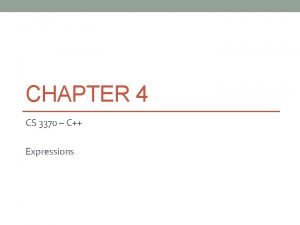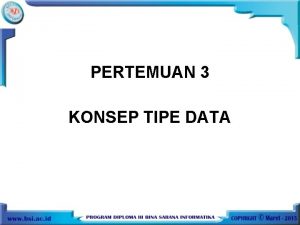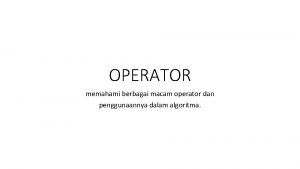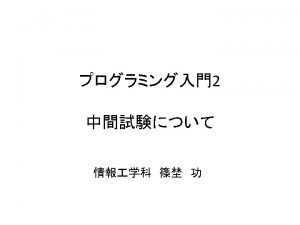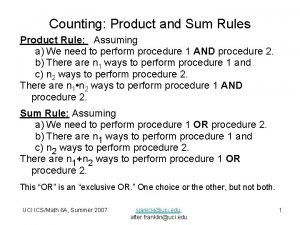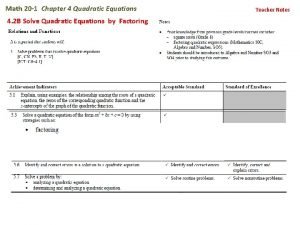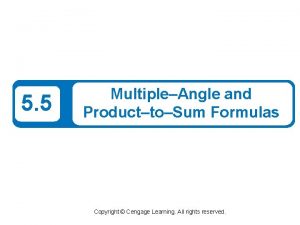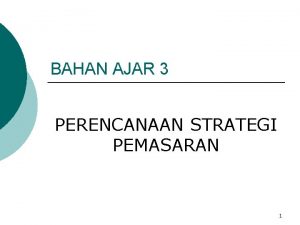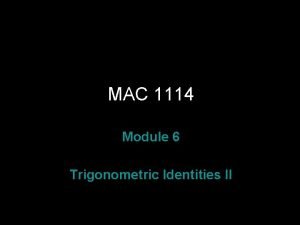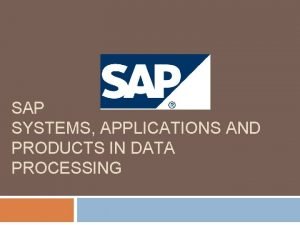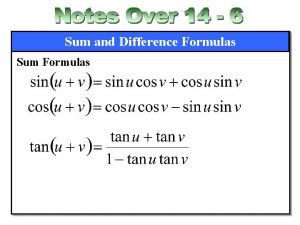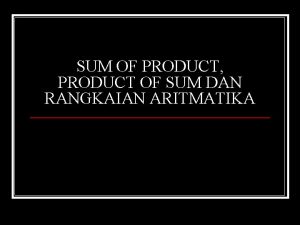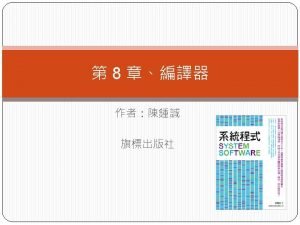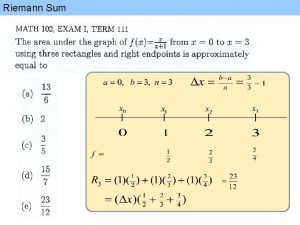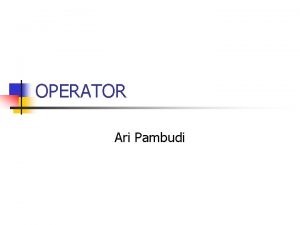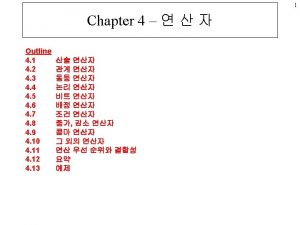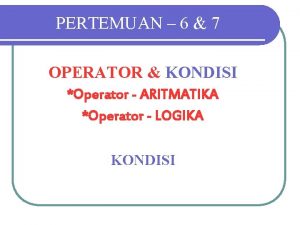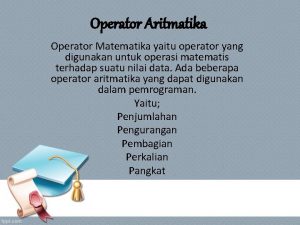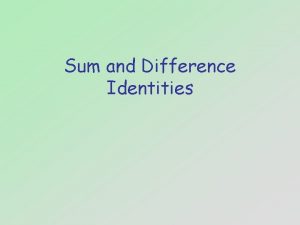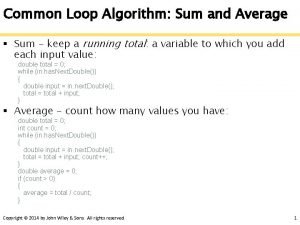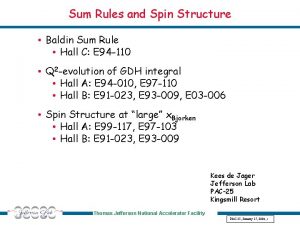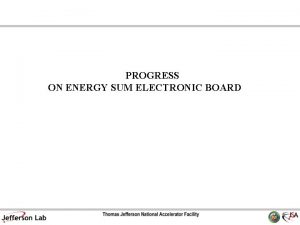Application of the operator product expansion and sum

























- Slides: 25

Application of the operator product expansion and sum rules to the study of the single-particle spectral density of the unitary Fermi gas ar. Xiv: 1501: 06053 [cond. mat. qunat-gas] Seminar at Yonsei University 12. 02. 2015 Philipp Gubler (ECT*) Collaborators: N. Yamamoto (Keio University), T. Hatsuda (RIKEN, Nishina Center), Y. Nishida (Tokyo Institute of Technology)

Contents n Introduction q The unitary Fermi gas n q n Recent theoretical developments The method q n Bertsch parameter, Tan’s Contact The operator product expansion Formulation of sum rules Results: the single-particle spectral density Conclusions and outlook

Introduction The Unitary Fermi Gas A dilute gas of non-relativistic particles with two species. Unitary limit: only one relevant scale Universality

Any relevance for the real world? It has only recently become possible to reach the unitary limit experimentally by tuning the scattering length by making use of a Feshbach resonance: Scattering length of Na atoms near a Feshbach resonance S. Inouye et al. , Nature 392, 151 (1998).

Example of universality M. Horikoshi et al. , Science, 327, 442 (2010). Measured using the two lowest spin states of 6 Li atoms in a magnetic field. Ideal Fermi Gas This is a universal function applicable to all strongly interacting fermionic systems. Unitary Fermi Gas

Parameters charactarizing the unitary fermi gas (1) The “Bertsch problem” What are the ground state properties of the many-body system composed of spin ½ fermions interacting via a zero-range, infinite scattering length contact interaction. (posed at the Many-Body X conference, Seattle, 1999) Or, more specifically: what is the value of ξ? Bertsch parameter

Values of ξ during the last few years ~ 0. 37 M. G. Endres, D. B. Kaplan, J. -W. Lee and A. N. Nicholson, Phys. Rev. A 87, 023615 (2013).

Parameters charactarizing the unitary fermi gas (2) The “Contact” C interaction energy kinetic energy Tan relations S. Tan, Ann. Phys. 323, 2952 (2008); 323, 2971 (2008); 323, 2987 (2008).

What is C? : Number of pairs Number of atoms with wavenumber k larger than K

What is the value of C? Experiment Theory S. Gandolfi, K. E. Schmidt and J. Carlson, Phys. Rev. A 83, 041601 (2011). Using Quantum Monte-Carlo simulation: 3. 40(1) J. T. Stewart, J. P. Gaebler, T. E. Drake, D. S. Jin, Phys. Rev. Lett. 104, 235301 (2010).

Deriving the Tan-relations with the help of the operator product expansion Zero-Range model: Operator corresponding to the contact density: E. Braaten and L. Platter, Phys. Rev. Lett. 100, 205301 (2008).

General OPE: Starting point: expression for momentum distribution: OPE (non-trivial) E. Braaten and L. Platter, Phys. Rev. Lett. 100, 205301 (2008).

take the expectation value After Fourier transformation: C E. Braaten and L. Platter, Phys. Rev. Lett. 100, 205301 (2008).

Further application of the OPE: the single-particle Green’s function location of pole in the large momentum limit Y. Nishida, Phys. Rev. A 85, 053643 (2012).

Comparison with Monte-Carlo simulations OPE results Quantum Monte Carlo simulation P. Magierski, G. Wlazłowski and A. Bulgac, Phys. Rev. Lett. 107, 145304 (2011). Y. Nishida, Phys. Rev. A 85, 053643 (2012).

Our approach PG, N. Yamamoto, T. Hatsuda and Y. Nishida, ar. Xiv: 1501. 06053 [cond-mat. quant-gas].

MEM PG, N. Yamamoto, T. Hatsuda and Y. Nishida, ar. Xiv: 1501. 06053 [cond-mat. quant-gas].

The sum rules The only input on the OPE side: Contact ζ Bertsch parameter ξ PG, N. Yamamoto, T. Hatsuda and Y. Nishida, ar. Xiv: 1501. 06053 [cond-mat. quant-gas].

Results Im Σ Re Σ A |k|=0. 0 |k|=0. 6 k. F |k|=1. 2 k. F In a mean-field treatment, only these peaks are generated PG, N. Yamamoto, T. Hatsuda and Y. Nishida, ar. Xiv: 1501. 06053 [cond-mat. quant-gas].

Results pairing gap PG, N. Yamamoto, T. Hatsuda and Y. Nishida, ar. Xiv: 1501. 06053 [cond-mat. quant-gas].

Comparison with other methods Monte-Carlo simulations Luttinger-Ward approach P. Magierski, G. Wlazłowski and A. Bulgac, Phys. Rev. Lett. 107, 145304 (2011). R. Haussmann, M. Punk and W. Zwerger, Phys. Rev. A 80, 063612 (2009). Qualitatively consistent with our results, except position of Fermi surface.

Conclusions n Unitary Fermi Gas is a strongly coupled system that can be studied experimentally q n n n Test + challenge for theory Operator product expansion techniques have been applied to this system recently We have formulated sum rules for the single particle self energy and have analyzed them by using MEM Using this approach, we can extract the whole singleparticle spectrum with just two inputparameters (Bertsch parameter and Contact)

Outlook n Generalization to finite temperature q n n Study possible existence of pseudo-gap Role of so far ignored higher-dimensional operators Spectral density off the unitary limit Study other channels …

Backup slides

Taken from: M. Randeria, Nature Phys. 6, 561 (2010). How can the unitary limit be understood in a broader context? Key parameter: k. Fa well understood difficult well understood C. A. R. Sá de Melo, M. Randeria and J. R. Engelbrecht, Phys. Rev. Lett. 71, 3202 (1993).
 Unary binary operator
Unary binary operator Pada tipe data boolean, berlaku operator-operator :
Pada tipe data boolean, berlaku operator-operator : Pada tipe data boolean berlaku operator-operator
Pada tipe data boolean berlaku operator-operator Prioritas operator
Prioritas operator Sum0
Sum0 Sum and product softuni
Sum and product softuni 5-5 multiple-angle and product-to-sum identities
5-5 multiple-angle and product-to-sum identities Rule of sum and product
Rule of sum and product Quadratic equations with fractions
Quadratic equations with fractions Product rule for counting
Product rule for counting Multiple-angle and product-to-sum formulas
Multiple-angle and product-to-sum formulas Ansoff product market expansion grid
Ansoff product market expansion grid Half angle formula examples
Half angle formula examples Product of sum adalah
Product of sum adalah Sum product networks
Sum product networks Factoring using diamond method
Factoring using diamond method Sap in data processing
Sap in data processing New product development and product life cycle strategies
New product development and product life cycle strategies Average product of labor
Average product of labor Product mix product line
Product mix product line Industry/target market feasibility analysis example
Industry/target market feasibility analysis example Gnp and gdp
Gnp and gdp Hình ảnh bộ gõ cơ thể búng tay
Hình ảnh bộ gõ cơ thể búng tay Lp html
Lp html Bổ thể
Bổ thể Tỉ lệ cơ thể trẻ em
Tỉ lệ cơ thể trẻ em
